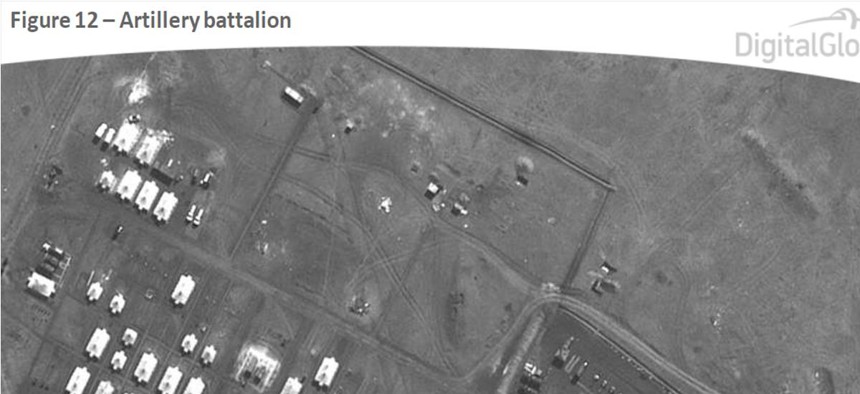
This satellite image, released by NATO, shows Russian artillery battalions at a camp near Ukraine's border on March 27th, 2014. Digital Globe via NATO SHAPE
Ukraine Crisis Has Triggered Unprecedented Spying From the Sky
With few eyes on the ground, concerned nations have taken to the skies to find out what's going on at the Russia-Ukraine border. By Marina Koren
The level of intel about where Russian troops are or aren't these days is pretty murky. Moscow says not one troop is stationed near eastern Ukraine. Satellite imagery and grainy photographs show otherwise. It's all big mess.
Such global-scale uncertainty has led several countries to take to the skies to sort everything out. As a result of the Ukraine crisis, an emergency provision in a massive military agreement was invoked last month for the first time in its 12-year existence, State Department officials said this week.
The Treaty on Open Skies, in effect since 2002, is a peaceful program for conducting unarmed, aerial surveillance flights over the entire territory of its 34 member states, which includes the United States, Russia, and Ukraine, as well as most European and some Asian nations.
Until recently, all flights under that treaty had been routine. But in March, Ukraine requested two "extraordinary" flight observations over Ukrainian territory to find out whether Russian forces had moved beyond Crimea, according to Anita Friedt, acting assistant secretary of State at the department's Bureau of Arms Control, Verification and Compliance.
In response, Sweden, joined by military personnel from Norway, Belgium, and the United Kingdom, flew from Kiev to Odessa on March 13. The next day, U.S. aircraft, along with Canadian and Estonian observers, surveyed Ukraine's border with Russia. The week after that, Russia allowed Ukraine to fly over its territory near their shared border.
"These flights provided reassurance to Ukraine and demonstrated our commitment to work with allies to uphold key elements of the Euro-Atlantic security architecture," Friedt said Tuesday during a House Foreign Affairs Committee hearing on U.S.-Russia nuclear-arms negotiations.
This week, the U.S. is conducting five additional extraordinary flights over eastern Ukraine, and a number of U.S. allies are preparing some of their own.
As the standoff in Eastern Europe continues, the region's airspace is going to see a lot more planes.
This is not surprising. Aerial observation is crucial during regional crises, especially when international monitors can't get on the ground to witness the conflict firsthand. The practice helps to locate military forces and track their movements, and provides fast imagery analysis. It even gives countries a concrete showing of concern—if you're sending planes on a fact-finding mission somewhere, you care about what's happening there.
And when it comes to the Treaty on Open Skies, everyone involved is fair game. The agreement gives all participants, regardless of landmass, from behemoth Russia to tiny Belgium, the option to gather information about other countries' military forces.
And transparency is big—the treaty stipulates that information that one nation finds during aerial surveillance must be shared with all members. A joint U.S.-German mission on March 24 over the Russian-Ukrainian border provided to all treaty participants images that helped substantiate Russian military activity in Belgorod, Boguchar, and Rostov—which Moscow has denied.
The concept of mutual aerial surveillance was first proposed by President Eisenhower to Soviet Premier Nikolai Bulganin in 1955. The Soviets, naturally, rejected the idea. Decades later, President George H.W. Bush took up the initiative, and it was signed by members of the North Atlantic Treaty Organization and the Warsaw Pact in 1992. The treaty took effect in 2002.
The treaty's founding year coincided with the crisis in the former Republic of Yugoslavia, which would split the country in two. The conflict led world leaders to consider the benefit of continuous aerial observations for future similar situations. After some negotiations, treaty participants agreed on a provision that would allow concerned parties to request extraordinary observation flights above routine level.
So, if you're concerned about the flow of information during a crisis like, say, one country's takeover of another's territory, you can put in a request for special flights with the Open Skies Consultative Commission. But remember: You can fly, but you can't hide. The information your mission gathers must be shared with your fellow treaty participants—even your enemies.




